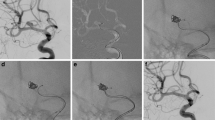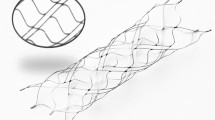Abstract
Purpose
Since appearance of the balloon-remodeling technique and stent-assisted coiling, complex aneurysms have been treated successfully by endovascular means worldwide. Although these two techniques have been widely proven, the combination of both traditionally made the procedures more complicated technically. The aim of our study was to determine the technical success, safety, and efficacy of the low-profile stents delivered through double lumen balloons.
Methods
Clinical, procedural, and angiographic data were analyzed.
Results
Eighty-four patients (55 women; age range 20–81 years) harboring 86 aneurysms were included in this study. Aneurysm maximal diameter ranged from 2 to 26 mm, with mean 7.5 mm. There were 62 unruptured, 15 recanalized, and 9 acutely ruptured aneurysms. Aneurysm locations were ACoA (31), MCA (36), supraclinoid ICA (4), carotid bifurcation (2), basilar (7), PCA (3), PICA (2), and VA (1). Ninety-three devices were implanted (63 LVIS jr, 15 LEO Baby, 14 ACCLINO Flex and 1 Neuroform Atlas) through the double lumen balloons (Scepter C or XC and Eclipse 2 L). We found 2 minor clinical events (2.4%) and 1 major event (1.2%). Total intra-procedural technical complication rate was 11.6%. Follow-up was available for 71 patients with an average follow-up of 7 months. Complete and near complete occlusion was 90.1%. Residual aneurysms were seen in 9.9%.
Conclusion
The “combined remodeling technique” with low-profile stents delivered through double-lumen balloons is technically feasible, safe, and effective for the treatment of intracranial aneurysms. This technique allows the operator to avoid extra maneuvers.
Similar content being viewed by others
Abbreviations
- CRT:
-
Combined remodeling technique
References
Tan IY, Agid RF, Willinsky RA (2011) Recanalization rates after endovascular coil embolization in a cohort of matched ruptured and unruptured cerebral aneurysms. Interv Neuroradiol 17(1):27–35
Moret J, Cognard C, Weill A, Castaings L, Rey A (1997) The “remodelling technique” in the treatment of wide neck intracranial aneurysms. Angiographic results and clinical follow-up in 56 cases. Interv Neuroradiol 3:21–35
Shapiro M, Babb J, Becske T, Nelson PK (2008) Safety and efficacy of adjunctive balloon remodeling during endovascular treatment of intracranial aneurysms: a literature review. AJNR Am J Neuroradiol 29:1777–1781
Piotin M, Blanc R (2014) Balloons and stents in the endovascular treatment of cerebral aneurysms: vascular anatomy remodeled. Front Neurol 5:41
Wang F, Chen X, Wang Y, Bai P, Wang HZ, Sun T, Yu HL (2016) Stent-assisted coiling and balloon-assisted coiling in the management of intracranial aneurysms: a systematic review & meta-analysis. J Neurol Sci 364:160–166
Consoli A, Vignoli C, Renieri L et al (2016) Assisted coiling of saccular wide-necked unruptured intracranial aneurysms: stent versus balloon. NeuroIntervent Surg 8:52–57
Chalouhi N, Starke RM, Koltz MT, Jabbour PM, Tjoumakaris SI, Dumont AS, Rosenwasser RH, Singhal S, Gonzalez LF (2013) Stent-assisted coiling versus balloon remodeling of wide-neck aneurysms: comparison of angiographic outcomes. AJNR Am J Neuroradiol 34:1987–1992
Spiotta AM, Miranpuri A, Chaudry M, Turner RD IV, Turk AS (2013) Combined balloon stent technique with the scepter C balloon and low-profile visualized intraluminal stent for the treatment of intracranial aneurysms. J Neuro-Oncol 5(Suppl 3):iii79–iii82
Kadziolka K, Tomas C, Robin G et al (2013) Combined use of a double-lumen remodeling balloon and a low-profile stent in the treatment of intracranial aneurysms (‘remostent’ technique): a technical note. J Neuroradiol 40:50–53
Park SY, Oh JS, Oh HJ, Yoon SM, Bae HG (2017) Safety and efficacy of low-profile, self-expandable stents for treatment of intracranial aneurysms: initial and midterm results - a systematic review and meta-analysis. Interv Neurol 6(3–4):170–182
Ferns SP, Sprengers ME, van Rooij WJ et al (2009) Coiling of intracranial aneurysms: a systematic review on initial occlusion and reopening and retreatment rates. Stroke 40(8):e523–e529
Dabus G, Brinjikji W, Amar AP, Delgado Almandoz JE, Diaz OM, Jabbour P et al (2018) Angiographic and clinical outcomes of balloon remodeling versus unassisted coil embolization in the ruptured aneurysm cohort of the gel the Nec study. J Neurointervent Surg 10(5):446–450
Piotin M, Blanc R, Spelle L et al (2010) Stent-assisted coiling of intracranial aneurysms. Clinical and angiographic results in 216 consecutive aneurysms. Stroke. 41:110–115
Pierot CC, Anxionnat R et al (2011) Remodeling technique for endovascular treatment of ruptured intracranial aneurysms had a higher rate of adequate postoperative occlusion than did conventional coil embolization with comparable safety. Radiology. 258(2):546–553
Gentric JC, Biondi A, Piotin M, Mounayer C, Lobotesis K, Bonafé A, Costalat V (2015) Balloon remodeling may improve angiographic results of stent-assisted coiling of unruptured intracranial aneurysms. Neurosurgery 76:441–445
Mocco SKV, Albuquerque FC et al (2009) Treatment of intracranial aneurysms with the Enterprise stent: a multicenter registry. J Neurosurg 110(1):35–39
Biondi JV, Katz JM et al (2007) Neuroform stent-assisted coil embolization of wide-neck intracranial aneurysms: strategies in stent deployment and midterm follow-up. Neurosurgery. 61(3):460–468
Shankar JJS, Quateen A, al WA (2016) Canadian registry of LVIS Jr for treatment of intracranial aneurysms (CaRLA). J NeuroIntervent Surg 0:1–5
Aydin K, Arat A, Sencer S, Barburoglu M, Men S (2015) Stent-assisted coiling of wide-neck intracranial aneurysms using low-profile LEO baby stents: initial and midterm results. AJNR Am J Neuroradiol 36(10):1934–1941
Cay F, Peker A, Arat A (2018) Stent-assisted coiling of cerebral aneurysms with the Neuroform Atlas stent. Interv Neuroradiol 24(3):263–269
Tureli D, Sabet S, Senol S, Andac N, Donmez H, Geyik S, Baltacioglu F, Cekirge S (2016) Stent-assisted coil embolization of challenging intracranial aneurysms: initial and mid-term results with low-profile ACCLINO devices. Acta Neurochir 158:1545–1553
Yoo E, Kim DJ, Kim DI, Lee JW, Suh SH (2009) Bailout stent deployment during coil embolization of intracranial aneurysms. AJNR Am J Neuroradiol 30:1028–1034
Funding
No funding was received for this study.
Author information
Authors and Affiliations
Corresponding author
Ethics declarations
Conflict of interest
GD consults for Microvention/Terumo.
Ethical approval
All procedures performed in the studies involving human participants were in accordance with the ethical standards of the institutional and/or national research committee and with the 1964 Helsinki Declaration and its later amendments or comparable ethical standards.
Informed consent
Informed consent was obtained from all individual participants included in the study.
Additional information
Publisher’s note
Springer Nature remains neutral with regard to jurisdictional claims in published maps and institutional affiliations.
Rights and permissions
About this article
Cite this article
Martínez-Galdámez, M., Orlov, K., Kadziolka, K. et al. Safety and efficacy of intracranial aneurysm embolization using the “combined remodeling technique”: low-profile stents delivered through double lumen balloons: a multicenter experience. Neuroradiology 61, 1067–1072 (2019). https://doi.org/10.1007/s00234-019-02240-x
Received:
Accepted:
Published:
Issue Date:
DOI: https://doi.org/10.1007/s00234-019-02240-x




